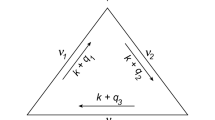Summary
The triangle graph for three-body production or decay processes is considered as a function of an internal mass. The discontinuities of the graph with respect to this variable are of special importance, since they form the kernel of the integral equation which determines all rescattering effects due to competing two-body final-state interactions. The main part of the kernel is given by one particular discontinuity, and this is recalculated here by dispersion methods which are basically well understood. The result agrees with that previously found by the use of Cutkosky's rules supplemented by some techniques of homology theory. It is gratifying that the result can be obtained by relatively straightforward methods; and that Cutkosky's rules can indeed be used for calculating the discontinuity in an internal mass variable. A byproduct of the calculation is a prescription for calculating the discontinuity of the graph in a given channel from a single-variable representation of it in a crossed channel. Applications to three-particle processes are mentioned.
Riassunto
Si studia il grafico triangolare per i processi di produzione o decadimento di tre corpi in funzione di una massa interna. Le discontinuità del grafico rispetto a questa variabile sono di speciale importanza, poichè formano il nòcciolo dell'equazione integrale che determina tutti gli effetti di riscattering dovuti alla competizione delle interazioni dello stato finale di due corpi. La parte principale del nòcciolo è data da una particolare discontinuità, ed essa è qui nuovamente calcolata con metodi di dispersione che sono fondamentalmente ben conosciuti. I risultati concordano con quelli trovati precedentemente con l'uso delle regole di Cutkosky completate con alcune tecniche della teoria dell'omologia. È soddisfacente che i risultati possano essere ottenuti con metodi relatimente immediati; e che le regole di Cutkosky possano proprio essere usate per calcolare la discontinuità in una variabile di massa interna. Un risultato accessorio del calcolo è una prescrizione per calcolare la discontinuità del grafico in un dato canale da una sua rappresentazione in una sola variabile in un canale incrociato. Si accenna alle applicazioni ai processi di tre particelle.
Similar content being viewed by others
Change history
09 January 2016
An Erratum to this paper has been published: https://doi.org/10.1007/BF02739104
References
But note that these conditions are not sufficient, see Sect 3 and ref. (2,3,11).
R. E. Norton:Phys. Res.,135, B 1381 (1964).
S. Coleman andR. E. Norton: to be published.
I. J. R. Aitchison andC. Kacser:Phys. Rev.,133, B 1239 (1964).
I. J. R. Aitchison:Phys. Rev.,137, B. 1070 (1965).
J. B. Bronzan andC. Kacser:Phys. Rev.,132, 2703 (1963); see also ref. (5).
R. E. Cutkosky:Journ. Math. Phys.,1, 429 (1960).
R. Karplus, C. M. Sommerfield andE. H. Wichmann:Phys. Rev.,111, 1187 (1958).
R. J. Eden:Lectures on the Use of Perturbation Methods in Dispersion Theory, University of Maryland, Physics Dept., Technical Report No. 211 (1961).
L. D. Landau:Nucl. Phys.,13, 181 (1959).
J. B. Bronzan:Phys. Rev.,134, B 687 (1964).
Note that this is the physical limit forf i.e. from below the λ2 cut. See ref. (6).
In ref. (5) this quantity was called the discontinuity around the λ2=(m—1)2 branch point; see the remarks at the end of the present section. The normalization off in eq. (5) (next page) has been chosen to correspond to that used in ref. (5).
As can be seen by continuing eq. (7) below λ=m+1, we must take that determination ofB which does not vanish as λ→4.
In fact, this is how the representation (5) was proved.
One of us, I.J.R.A., is grateful to Mr.D. Branson for pointing this out to him.
D. Fotiadi, M. Froissart, J. Lascoux andF. Pham: to be published.
F. Pham: private communication.
N. Mishima andM. Yamazaki: (Tokyo preprint, 1965). The idea, however, was already contained in the work ofJ. Tarski andR. Blankenbecler:Phys. Rev.,125, 782 (1962). See also Appendix A of the paper byJ. S. Ball, W. Frazer andM. Nauenberg:Phys. Rev.,128, 478 (1962).
Author information
Authors and Affiliations
Additional information
Sponsored in part by the Air Force Office of Scientific Research, OAR, under Grant No. AF EOAR 63-79 with the European Office of Aerospace Research, United States Air Force.
Supported in part by the National Science Foundation under Grant No. NSF GP 3221.
Traduzione a cura della Redazione.
Rights and permissions
About this article
Cite this article
Aitchison, I.J.R., Kacser, C. Singularities and discontinuities of the triangle graph, as a function of an internal mass. Nuovo Cimento A (1965-1970) 40, 576–588 (1965). https://doi.org/10.1007/BF02721045
Received:
Published:
Issue Date:
DOI: https://doi.org/10.1007/BF02721045



